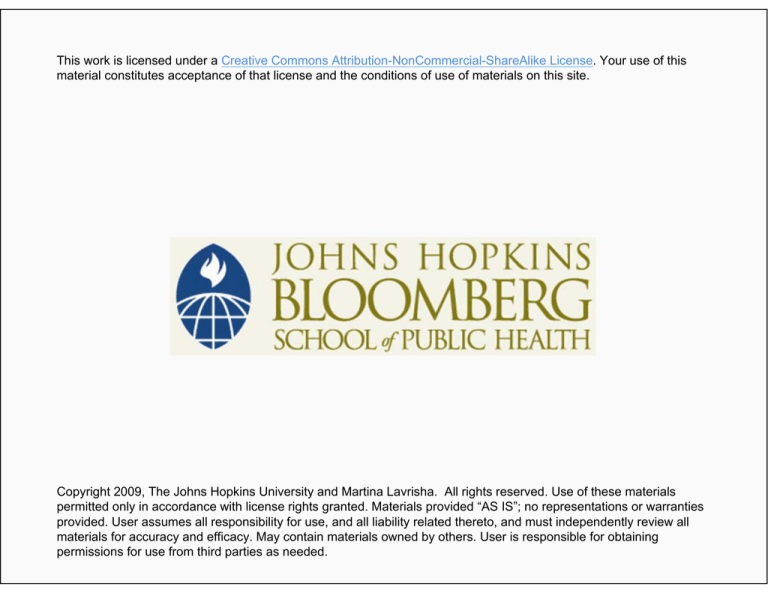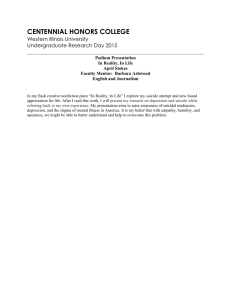
This work is licensed under a Creative Commons Attribution-NonCommercial-ShareAlike License. Your use of this
material constitutes acceptance of that license and the conditions of use of materials on this site.
Copyright 2009, The Johns Hopkins University and Martina Lavrisha. All rights reserved. Use of these materials
permitted only in accordance with license rights granted. Materials provided “AS IS”; no representations or warranties
provided. User assumes all responsibility for use, and all liability related thereto, and must independently review all
materials for accuracy and efficacy. May contain materials owned by others. User is responsible for obtaining
permissions for use from third parties as needed.
Mental Illness in the Workplace
Martina Lavrisha, RNC, MSN MPH
Johns Hopkins University
Introduction
Jacqueline Agnew introduces Martina Lavrisha
3
Section A
Global Burden of Disease
Headlines in January and February 2009
Headlines on UPI and Yahoo! News in January and February 2009
− Sailor killed in murder-suicide
−
−
−
−
−
Murder-suicides may be “tip of iceberg”
Job woes blamed for LA murder-suicide
Army suicides at record high, passing civilians
Army reports alarming rise in suicides last month
Mike Whitmarsh, former beach volleyball Olympian, dies at 46
X
Autopsy shows Whitmarsh committed suicide with carbon
monoxide from car exhaust
5
Global Burden of Disease
Cardiovascular Conditions
18.6%
Mental Disorders
15.4%
Cancer
15.0%
Others
51%
Source: Murray and Lopez. (1996). Global burden of disease.
6
Illnesses with Highest Economic Burden on Employer
Chronic illnesses with highest economic burden on employer
− Hypertension: $392 per eligible employee per year
−
−
−
Heart disease: $368
Depression and other mental illnesses: $348
Arthritis: $327
Source: Goetzel et al., (2004).
7
Incidence of Mental Illness in the U.S.
26.2 percent of Americans ages 18 and older, or one in four adults
(57.7 million Americans), will experience a form of mental illness in
a given year (NIMH, 2004)
8
Cost of Mental Illness in the U.S.
The cost of mental illness in both the private and public sectors in
the U.S. is $205 billion
Direct treatment costs are $92 billion, with $105 billion due to lost
productivity, and an additional $8 billion resulting from crime and
welfare costs related to the illness
The cost of untreated and mistreated mental illness to American
businesses, the government, and families has grown to $113 billion
annually
Rice and Miller. (1998).
9
Hospital Costs of Mental Health Disorders in 2006
One out of every five hospital stays (21.3 percent) had either a
principal or secondary diagnosis of a mental health condition
Medicare and Medicaid were the payers for 6 out of every 10 mental
health stays, while private insurance paid for slightly more than 2
out of 10 of these stays
−
Slightly less than 1 out of 10 mental health stays were uninsured
Mood disorders and schizophrenia were responsible for 82 percent of
all mental health hospitalizations
For individuals 65 years and older, dementia and associated cognitive
disorders were the most common cause of mental health
hospitalizations (50%)
Source: AHRQ. (2008).
10
Hospital Stays: Mental Health vs. All Diagnoses
Characteristics of hospital stays for mental health compared to all
stays, for all age groups, 2006
All hospital stays
Mental health
principal diagnosis
All diagnoses
1,350,700
39,450,200
8.2
4.6
Mean charge per stay (dollars)
$15,400
$24,000
Mean charge per day (dollars)
$1,900
$5,200
Percent admitted from the ED
49.3%
43.8%
Percent admitted from another hospital
6.2%
3.5%
Percent admitted from long-term facility
3.6%
1.3%
Number of hospital stays
Mean length of stay (days)
Source: AHRQ, Center for Delivery, Organization, and Markets, Healthcare Cost and Utilization Project. Nationwide
inpatient sample, 2006.
11
Barriers to Treatment
Only 25–40% of individuals with symptoms seek treatment as unsure
of which type of provider to initiate treatment with or do not have
insight into their illness
Cost—uninsured, smaller companies may opt to not offer mental
health benefits
12
Barriers to Treatment
Access—mental health providers not taking insurance due to low
reimbursement rates, specialists found more in urban settings,
transportation, lack of mental health providers in remote areas,
office hours conflict with work schedule, difficulty navigating
insurance and disability systems
Stigma—viewed as personal weakness or defect; educational bias,
competing priorities for lower income individuals
Employment implications (military, security clearances)
13
Diagnostic and Treatment Options
Approximately 25–50% of individuals with mental illness are seen by
their primary care physician or practitioner, 25–40% of individuals see
a psychiatrist or mental health provider, and the remainder may see
other alternative providers (clergy, acupuncturist, massage
therapist)
Diagnosis is made based on presence of specific symptoms in DSM-IV,
absence of organic (brain tumor) or other medical conditions (thyroid
d/o, vitamin deficiency), side effect of medication(s)
The earlier the treatment, the better the outcome
−
Research has shown that a combination of medications/therapy
is most effective
14
Up-front Costs
Cost of comprehensive psychiatric evaluation ($400–600), more
frequent visits in first six months (co-payments), medications ($16
per prescription), therapy sessions ($100–250)
Cost of primary care MD/NP/PA visits based on complexity (copayments or out of pocket)
May see longer duration of symptoms if treated by primary care as
more likely to misdiagnose, order inadequate dosages of
medications, and are less likely to explore suicidal thoughts (40% of
suicide victims saw their primary care within a month of the event)
(Pomerantz, 2005)
15
Increased Costs
Increased costs with decrease in coverage or increased symptoms
−
−
A 30% cost reduction in mental health services at a large
Connecticut corporation triggered a 37% increase in medical
care use and sick leave by employees using mental health
services, thus costing the corporation more money rather than
less (Rosenheck et al., 1999)
Langlieb (2005) noted that if depressed employees were also
highly stressed, they spent 147% more on health care than those
who were depressed alone (based on the findings of a 1998 study
of 46,000 employees)
16
Section B
Mood Disorders
Mood Disorders
Depression
Bipolar disorder
Dysthymia
Seasonal affective disorder
18
Depression
Depression is a major public health problem, and increasing the
number of Americans with depression who receive treatment is an
important public health goal and a national objective of Healthy
People 2010 (DHHS, 2000)
19
Prevalence of Depression in U.S.
Depression affects 14.8 million adult Americans, or about 6.7% of the
U.S. population age 18 and older in a given year and is the leading
cause of disability for individuals ages 15–44 (NIMH, 2008)
20
Effects of Depression in Working Adults
In the U.S., clinical depression has become one of the most common
illnesses, affecting 1 in 10 working-age adults, resulting in a loss of
50 working days per depressed worker each year when untreated
In 2000, employers spent $26 billion in direct costs and lost an
additional $51.5 billion for absenteeism and reduced productivity
Source: Greenberg et al. (2003).
21
Depression: DSM-IV Criteria
Five or more of the following symptoms in the past two consecutive
weeks:
−
−
−
−
−
−
−
−
−
Depressed mood
Loss of interest/pleasure
Guilt or worthlessness
Sleep disturbance
Psychomotor agitation or retardation
Appetite change (increase or decrease)
Concentration difficulties
Energy loss
Suicidal ideation
22
Benefits of Depression Treatment for the Employer
When depression management included in health plan, productivity
increased over 6%, absenteeism declined by 28%, with a savings of
$2,601 per each depressed employee (Rost, 2004)
Other studies have shown depression treatment yielding cumulative
savings of $2,898 per 1,000 workers over five years and an additional
net savings of $4,633 per 1,000 workers (from reduced absenteeism
and employee turnover rates) by the second year of treatment
(Wang et al., 2006)
23
Unhappiest Cities (Business Week, 2009)
Rank
State
1
Portland, Ore.
2
St. Louis, Mo.
3
New Orleans, La.
4
Detroit, Mich.
5
Cleveland, Ohio
6
Jacksonville, Fla.
7
Las Vegas, Nev.
8
Nashville, Tenn.
9
Cincinnati, Ohio
10
Atlanta, Ga.
24
Bipolar Disorder: DSM-IV Criteria for Mania
Four or more of the following symptoms in the last week
− Feeling unusually “high,” euphoric, or irritable
−
−
−
−
Needing less sleep
Talking a lot or feeling unable to stop talking
−
Doing things impulsively with negative consequences (money,
sex, business)
−
−
Being easily distracted
Having lots of thoughts/ideas going through your head at one
time
Feelings of greatness
Making lots of plans for activities or feeling the need to keep
moving
25
Rates and Costs of Bipolar Disorder
Bipolar disorder affects more than 5.7 million adult Americans every
year, or 2.6 percent of the U.S. population aged 18 and older
(Kessler, Chiu, Demler, and Walters, 2005)
Higher rates (close to 50%) of suicide attempts reported, with 19%
succeeding (Jamison, 2000)
Individuals with bipolar disorder have a higher rate of substance
abuse or dependence—the ECA study found that approximately 56%
of patients with bipolar disorder abused or were dependent on drugs,
and approximately 44% had comorbid alcohol abuse (Regier et al.,
1990)
Comorbid alcoholism also increases the attempted suicide rate (38%
vs. 21% lifetime rate) among individuals with bipolar disorder (Potash
et al., 2000)
Lifetime cost of bipolar disorder based on a 1991 study was $45
billion, with lost productivity and early death accounting for $38
billion (Wyatt and Henter, 1995)
26
Treatment of Mood Disorders
Antidepressants, mood stabilizers, antipsychotics, anxiolytics,
sedatives
Therapy—cognitive, behavioral, family, group, phototherapy, TMS,
VNS
Support groups
27
Treatment of Mood Disorders
Antidepressants, mood stabilizers, antipsychotics, anxiolytics,
sedatives
Therapy—cognitive, behavioral, family, group, phototherapy, TMS,
VNS
Support groups
ECT
Exercise
Nutrition
28
Anxiety Disorders
Single phobia (agoraphobia, claustrophobia)
Social anxiety disorder
Post–traumatic stress disorder
Generalized anxiety disorder
Panic disorder
Obsessive-compulsive disorder
29
Rates and Costs of Anxiety Disorders
Approximately 40 million American adults ages 18 and older (18.1%)
in a given year have an anxiety disorder (Kessler, Chiu, Demler, and
Walters, 2005)
Anxiety disorders are highly treatable, yet only about one-third of
those suffering from an anxiety disorder receive treatment
Having multiple types of anxiety disorders (PTSD, phobia, panic
disorder) increases risk of suicide (Sareen et al., 2005)
The direct costs of treating anxiety disorders is $42 billion a year
30
Treatment of Anxiety Disorders
Anxiolytics, antidepressants
Therapy—cognitive behavioral, desensitization, EFT
Support groups
Relaxation techniques, stress management
Exercise
31
Suicide
Suicide rates are on the rise worldwide—WHO estimates that 1.53
million people will die from suicide in 2020, averaging 1 death every
20 seconds and one attempt every one to two seconds (Bertolote and
Fleischmann, 2002)
32
Suicide
Suicide took the lives of 32,439 Americans in 2004 (NIMH, 2009)
86 suicides daily; 1 suicide every 17 minutes, annual rate of 10.9 per
100,000
More people die from suicide than from homicide—in 2000, there
were 1.7 times as many suicides as homicides
Overall, suicide is the 11th leading cause of death for all Americans,
and is the third leading cause of death for young people aged 15–24
−
Rates of completed suicide are highest among the elderly over
85—elderly adults have suicide rates close to 50% higher than
the nation as a whole
2008 suicide rates in the Army are at all time high—20.2 per 100,000
soldiers, Marine Corps rates, at 19 per 100,000 troops, are also
higher than national rates (AP, 2009)
33
Suicide by Gender, Race
Males are more than four times more likely to die from suicide than are
females; however, females attempt suicide three times more often than
males
52% of suicides in 2005 were committed with a firearm (men use firearms
more readily while females choose poisoning)
In 2005, white males accounted for 72% of all suicides
−
Together, white males and females accounted for over 90% of all
suicides (U.S. Suicide Statistics, 2005)
Between 1999 and 2005, there was an increase in the overall suicide rate,
especially in whites aged 40–64, with white women experiencing the largest
annual increase of 3.9 percent, and the rate among white men rose 2.7
percent annually (Hu et al., 2008)
From 1979–1992, suicide rates for Native Americans (American Indians and
Alaska Natives) were about 1.5 times the national rates
−
There was an increased number of suicides among young male Native
Americans during this period, as males 15–24 accounted for 64% of all
suicides by Native Americans (APA, 1999)
34
States with Highest Suicide Rates, 2005
U.S. Suicide Statistics (2005)
Rank
State
Number
Rate
1
Montana
206
22.0
2
Nevada
480
19.9
3
Alaska
131
19.7
4
New Mexico
342
17.7
4
Wyoming
90
17.7
6
Colorado
800
17.1
7
Idaho
228
16.0
8
Arizona
945
15.9
9
South Dakota
121
15.6
10
Oregon
560
15.4
35
Substance Abuse and Dependence
Substance abuse and dependence
36
Substance Abuse and Dependence
Substance dependence or abuse in the past year among persons aged
12 or older: 2002–2007 (SAMHSA, 2008)
37
Substance Abuse and Dependence
Alcohol dependence or abuse in the past year among adults aged 21
or older, by age at first use of alcohol: 2007 (SAMHSA, 2008)
38
Substance Abuse and Dependence
Dependence or abuse of specific illicit drugs in the past year among
persons aged 12 or older: 2007 (SAMHSA, 2008)
39
Substance Abuse and Comorbid Psychiatric Disorder
Rates of alcohol/substance abuse and comorbid psychiatric disorder
−
−
−
In individuals with an alcohol disorder, 37% also have a mental
disorder
In individuals with other substance abuse disorders, 53% have a
coexisting mental disorder
If addicted to one substance, odds are seven times greater than
general population to have another addiction (Regier et al.,
1990)
40
Substance Abuse Treatment
Medications: antidepressants, mood stabilizers, methadone,
bupronorphine, Revia, Antabuse
Support groups: AA, NA
Harm reduction approach
−
−
Reduce harm by providing clean syringes to reduce risk of HIV,
hepatitis
Overdose prevention—providing intramuscular Narcan and
educating adults with addictions on appropriate use with opiate
overdose
41
Legislation Mandate
The Drug-Free Workplace Act of 1988
−
−
Requires any organization that receives a federal contract worth
$100,000 or more to establish a drug-free workplace policy
It also requires all organizations receiving a federal grant of any
size to maintain such a policy
Source: SAMHSA. (2004).
42
Section C
Public Health Approach to Mental
Illness in the Work Setting
Primary Prevention
Openly recognizing mental illnesses
− World Mental Health Day (October 10)
−
−
−
−
−
−
Sponsoring “Out of the Darkness Walk” to raise awareness
and funds for suicide prevention
National alcohol screening day (April)
National depression or national anxiety screening days
(October 8)
Offering courses on stress management, anger
management, problem solving, communication skills,
addictions
Offering incentives to join a gym
Offering employee assistance program (EAP)
44
Secondary Prevention—Treatment
Be aware of symptoms
−
−
−
−
If someone’s performance is down, increased absence from
work, difficulty concentrating, decreased attention to hygiene,
bizarre behavior, exaggerated response to a stressor or change
within the organization, referral to EAP or mental health is
advised
Goal of treatment is to stabilize symptoms and prevent relapse
(absence of symptoms for 4–9 months)
Can refer to network of providers through insurance carrier,
contracted mental health providers, suicide hotline (1-800-273TALK), drug treatment, FMLA
Support workplace accommodations to enhance productivity
45
Tertiary Prevention
The maintenance phase of treatment is maintaining the highest level
of functioning through medications, therapy, vocational
rehabilitation, workplace accommodations, social services,
methadone or other substance-maintenance treatment, nutrition,
and stress management
46
Work Accommodations for Depressed
Reduce distractions in the work area
Increase natural lighting or provide full-spectrum lighting
Allow the employee to work from home and provide necessary
equipment
Allow for frequent breaks
Divide large assignments into smaller tasks and goals
Restructure job to include only essential functions
Source: ODEP. (2008).
47
Work Accommodations for Anxiety Disorder
Recognize that a change in the office environment or of supervisors
may be difficult for a person with an anxiety disorder
Refer to counseling and employee-assistance programs
Provide a self-paced work load and flexible hours
Allow employee to work from home during part of the day or week
Source: ODEP. (2008).
48
Work Accommodations for Substance Abuse
Allow use of paid or unpaid leave for inpatient medical treatment
Allow use of paid or unpaid leave or flexible scheduling for
counseling or to attend support meetings
Allow modified daily schedule
Provide a self-paced workload
Reassign to a less stressful job
Source: ODEP. (2008).
49
Conclusion
Mental illness is likely to be encountered in the occupational health
setting as one in four American workers are likely to experience a
mental illness during their lifetime
Research has shown there is benefit to the inherent up-front costs of
psychiatric treatment by reducing the duration of symptoms,
improving productivity, and reducing the burden to society
Strategies to improve the mental health of all employees include
open discussion of mental health and illness, early detection and
referral of suspected mentally ill workers, and employer support of
reintegration through accommodations in the workplace
50
Section D
Q & A with Jackie Agnew
Q & A with Jackie Agnew
What are some of the things an employer can do to make a layoff as
easy as possible for an employee?
52
Q & A with Jackie Agnew
What dilemmas are faced in working with someone with mental
illness?
53
Q & A with Jackie Agnew
How do you go about finding employee assistance programs?
54
Q & A with Jackie Agnew
What are some workplace interventions?
55
Q & A with Jackie Agnew
What is World Mental Health Day?
56









